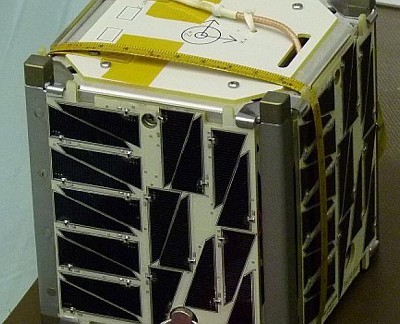TechEdSat-3P
San Jose State University and University of Idaho (c/o NASA Ames Research Center)

The TechEdSAT-3p will be the first flight test of an Exo-Brake passive de-orbit system. TechEdSAT-3p is a triple cubesat (3U) with a set of dual advanced avionics systems powered by the previous core system. In 2U of the packaging (roughly 2/3 of the volume), there is stowed an erectable deployment system that would place the Exo-Brake in the desired orientation. Scaled as a 10 day experiment, the deployed system has the ballistic coefficient of 5 kg/m2 – and is constructed as a tension-based structure that would not entangle itself. During the de-orbit process, GPS data from the dual avionics as well as collected TLE (Two Line Elements) provided by the USSTRATCOM will be used to analyze the flight dynamics and compared to computational models. This experiment will be the antecedent of related experiments at larger scale (e.g., for a 1.5 day de-orbit) and controllability. The 3U cubesat was deployed from the ISS on the 20 November 2013 at 07:58 UTC
NASA-Catalog:
Downlink
437.465 MHz 1k2 AFSK, AX.25, 800mW
Call
Status
not heard
Orbital Parameter
Inclination 51.650 RA of A. Node 74.600 Eccentricity 0.0001020 Argument of Perigee 107.680 Revs per day 15.50207966 Period 1h 32m 53s (92.88 min) Semi-major axis 6 794 km Perigee x Apogee 415 x 417 km BStar (drag term) 0.000257330 1/ER Mean anomaly 280.995
TechEdSat-1
San Jose State University

TechEdSat is a NASA Ames Research Center 1U CubeSat built by San Jose State University Students in partnership with ÅAC Microtec. It’s mission is to evaluate Space Plug-and-play Avionics (SPA) designed in Sweden by ÅAC Microtec, and to perform a communications experiment utilizing the Iridium and Orbcomm satellite phone network.
NASA-Catalog: 38854
Downlink
437.465 MHz, 1k2 AFSK AX.25, FM
Call
KJ6TVO
Orbital Parameter
NORAD 38854 COSPAR designator 1998-067-CP Inclination 51.647 RA of A. Node 275.490 Eccentricity 0.0014651 Argument of Perigee 145.137 Revs per day 15.51582271 Period 1h 32m 48s (92.80 min) Semi-major axis 6 790 km Perigee x Apogee 402 x 422 km BStar (drag term) 0.000898790 1/ER Mean anomaly 215.074
Status
decayed on 05 May 2013

Mission
- Stensat Radio Beacon
- 4x nanoRTU (ÅAC Microtec)
- Main Power Distribution Board (ÅAC Microtec)
- RTU Lite (ÅAC Microtec)
- 2 meter band Monopole Antenna
- 70cm band Monopole Antenna
- 1600 MHz Patch Antenna
- Pumpkin, Inc. 1U Skeletonized CubeSat Structure
- Canon BP-930 Lithium-ion battery
TechEdSat Beacon Format
Operating at TBD MHz FM, the TechEdSat beacon sends an AX.25 packet every 30 seconds. The packet contains data about the spacecraft systems operation. The data portion of a standard AX.25 packet is 64 characters long. The beacon packet contains only standard ASCII characters. Each character after the URL ncasst.org represents a HEX value. All characters are selected from the set 0 – 9 and A – F. Below is an example of the 64-character long raw data string:
ncasst.org1086501A6429D58305957100B450193035E938FA03850A30256988
Two packet formats will be sent alternately (0 seconds send packet 1, 30 seconds send packet 2, 60 seconds send packet 1, etc…) The packet number, 1 or 2, is included in the packet. The elapsed timer and solar array status appear in both packets.